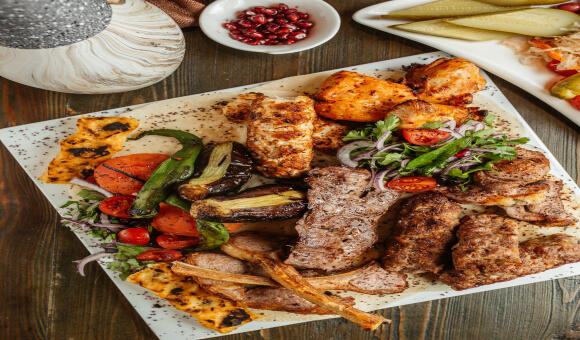Lebanese Restaurant Etiquette: How to Order and Eat Like a Local
Lebanese cuisine is renowned for its rich flavors, fresh ingredients, and communal dining culture. Whether you are visiting a Lebanese grills restaurant in your city or exploring some of the top Lebanese restaurants in Dubai, understanding the dining etiquette can enhance your experience and help you eat like a local. Lebanese dining is about more than just food it’s about hospitality, togetherness, and tradition. This guide will walk you through the essentials of ordering and eating at a Lebanese restaurant while following cultural norms.
Understanding the Lebanese Dining Culture
In Lebanon, food is more than sustenance it’s a way to connect with family and friends. Meals are often shared, with dishes placed in the center of the table so everyone can enjoy them together. This style encourages conversation and creates a relaxed, inviting atmosphere. Dining is seen as a leisurely activity, not something to be rushed.
One of the first things you’ll notice is the abundance of mezze small plates served before the main course. Mezze reflects the Lebanese approach to eating: variety, generosity, and balance.
Choosing Your Table
When dining in a traditional Lebanese setting, your table is not just a place to eat—it’s a place to gather and interact. Choose a table that allows you to face the people you are dining with, as eye contact and conversation are important parts of the experience.
If you’re in a group, expect the seating to be slightly informal. Lebanese dining is social and lively, and everyone is encouraged to share and participate.
How to Order Like a Local
Ordering at a Lebanese restaurant can feel overwhelming if you’re unfamiliar with the variety of dishes available. Here are some steps to help you order like a local.
Start with Cold Mezze
Cold mezze usually arrives first. Popular dishes include hummus, baba ghanoush, labneh, tabbouleh, and fattoush. Locals typically order several of these dishes to share. The idea is to enjoy a wide range of flavors, from creamy to tangy and refreshing.
Add Hot Mezze
Hot mezze comes next and includes dishes like kibbeh, sambousek, and grilled halloumi. This part of the meal adds warmth and depth to the dining experience. Lebanese people often mix hot and cold mezze on their plates, so don’t be afraid to combine flavors.
Move to the Main Course
The main course is often centered around grilled meats, especially in a Lebanese grills restaurant. Popular options include shish taouk (chicken skewers), kafta (minced meat skewers), and lamb chops. These are usually served with grilled vegetables, rice, or warm bread.
Order for the Table, Not the Individual
In Lebanon, food is meant to be shared. Instead of each person ordering a separate main dish, the table collectively decides on what to order, ensuring a mix of flavors and textures that everyone can enjoy.
Eating Etiquette at a Lebanese Restaurant
Eating like a local means embracing Lebanese customs at the table.
Share Generously
Sharing food is the heart of Lebanese dining culture. Mezze plates are placed in the center of the table, and everyone serves themselves. It’s polite to take small portions so that everyone has a chance to try each dish.
Use Bread as a Utensil
In Lebanese cuisine, bread is more than a side it’s a tool. Fresh pita or markouk bread is often used to scoop up dips or wrap grilled meat. Locals tear bread with their hands and use it to grab food rather than relying solely on a fork.
Eat Slowly and Savor the Flavors
Meals are meant to be enjoyed over time. Eating slowly allows you to appreciate the complexity of the flavors while enjoying the company of those around you.
Respect the Order of the Meal
Even though mezze is abundant, try to save room for the main course and dessert. Lebanese meals often end with fresh fruit, baklava, or a strong cup of Arabic coffee.
Cultural Considerations When Dining Out
Be Open to New Flavors
Lebanese cuisine is known for its balance of tangy, sweet, and savory notes. Even if a dish looks unfamiliar, locals encourage trying it. This openness is part of the dining experience.
Avoid Wasting Food
Lebanese culture values generosity, but it also respects food. Order enough to satisfy everyone, but try not to over-order to the point where large amounts are left uneaten.
Accept Offers of More Food
Hospitality is central to Lebanese dining, and it’s common for staff or hosts to encourage you to eat more. While it’s fine to politely decline when you’re full, accepting a little extra shows appreciation.
Drinking Etiquette
Water and Soft Drinks
Water is always present at the table, and soft drinks or fresh juices are common. Locals often enjoy fresh mint lemonade with their meal, which complements the savory dishes.
Alcoholic Beverages
While not all Lebanese restaurants serve alcohol, some do offer wine and beer. If you choose to drink, it’s polite to sip slowly and avoid overindulgence.
End with Coffee or Tea
Lebanese meals traditionally end with Arabic coffee or mint tea. This signals the close of the meal and offers a moment of calm after the feast.
Dining with Locals: What to Expect
When dining with locals, expect the experience to be longer and more interactive than a typical restaurant meal. Conversation flows easily, and food keeps coming. It’s not uncommon for meals to last several hours.
Hospitality Above All
Lebanese hospitality is legendary. Whether you’re at a casual eatery or a fine dining spot, expect to be warmly welcomed. Staff may check in frequently, offering more bread, refilling dishes, or suggesting additional items to try.
A Relaxed Pace
Unlike fast-paced dining environments, Lebanese meals are enjoyed without time pressure. This relaxed pace is an important part of the culture and allows you to connect with the food and the people.
Tips for a Memorable Lebanese Dining Experience
Go with a group – Lebanese dining is best enjoyed with friends or family so you can share more dishes.
Order a mix of familiar and new dishes – Try classics like hummus alongside something you haven’t had before.
Embrace the communal style – Pass plates around, share bread, and encourage others to try what’s in front of you.
Ask for recommendations – Servers often know the best seasonal or specialty dishes.
Finish strong with dessert and coffee – Ending the meal on a sweet note is an important part of the tradition.
Why Learning the Etiquette Matters
Knowing how to order and eat like a local not only makes your dining experience more enjoyable but also shows respect for the culture. Lebanese cuisine is built on centuries of tradition, and every detail—from the way food is served to the order in which it’s eaten has meaning.
Whether you’re enjoying the smoky flavors of grilled meats, savoring a spread of mezze, or lingering over coffee at the end of the meal, understanding the etiquette helps you appreciate the experience fully. It transforms a simple meal into a cultural journey, allowing you to connect with the Lebanese way of life.
Eating like a local at a Lebanese restaurant is about more than following rules It’s about embracing hospitality, celebrating flavors, and enjoying the shared joy of food. When you dine with an open mind and a generous spirit, you’re not just a customer you’re part of a tradition that has brought people together for generations.









 UnlockWare Group
UnlockWare Group
Comments (0)